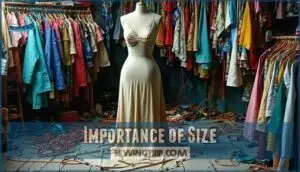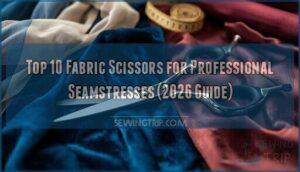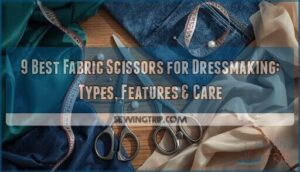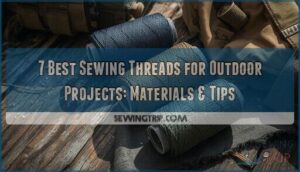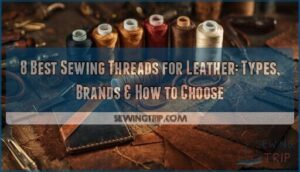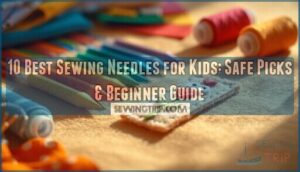This site is supported by our readers. We may earn a commission, at no cost to you, if you purchase through links.
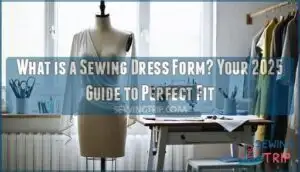
You’ll pin, drape, and adjust fabric on it, so your creations actually fit like a glove—no more guessing games or lopsided hems.
It’s like having a silent partner who never complains about pins, whether you’re tweaking a pattern or testing a wild new idea, a dress form helps you see how things look before you sew a single stitch.
Curious about which type is best for you? There’s more to discover ahead, with the help of a dress form.
Table Of Contents
Key Takeaways
- A sewing dress form is a sturdy, body-shaped tool that lets you pin, drape, and fit clothes for a precise, professional finish.
- You’ll get the best results by choosing a dress form that matches your size and shape, with adjustable options for flexibility.
- Dress forms are built for garment construction, not display, so you can create, alter, and perfect your designs with real accuracy.
- Maintaining your dress form—cleaning, rotating, and checking adjustments—keeps it reliable for years of sewing projects.
Dress Form Basics
A sewing dress form is your three-dimensional body replica that’ll revolutionize how you approach garment construction.
Meet your silent sewing partner—always ready, perfectly poised, and essential for flawless garment fitting.
Think of it as your silent sewing partner—always available, never complaining about pins, and maintaining perfect posture while you work.
These essential tools serve multiple fitting purposes, from creating precise patterns to achieving professional-looking alterations.
Unlike display mannequins you’d see in store windows, dress forms are specifically designed as draping aids for actual garment construction.
They’re built from durable form materials like foam-backed fabric or sturdy fiberglass that can withstand repeated pinning and adjustments.
Understanding the importance of body measurements and proportions is vital for selecting the correct form.
Whether you’re hemming a dress, adjusting shoulder seams, or creating entirely new designs, a dress form mannequin becomes indispensable.
You’ll find dress form sizes ranging from petite to plus-size, with many offering adjustable measurements to accommodate different projects.
The key difference?
While a regular mannequin focuses on display, your dress form for sewing prioritizes accuracy in dress form measurements, making it the perfect canvas for bringing your creative visions to life.
Importance of Size
When you’re choosing a dress form, size isn’t just about measurements—it’s about finding your sewing partner that’ll actually help instead of frustrate you.
A form that’s too far off from your body shape will have you constantly adjusting and re-pinning, turning what should be a smooth fitting process into a wrestling match with fabric.
Adjustability
When you’re hunting for the perfect fit, adjustable dress forms become your best friend. These clever tools use adjustment mechanisms with dials or wheels that modify bust, waist, and hip measurements—think of them as your personal fitting assistant.
The size adaptability means you can transform one form to match multiple body types, though dial calibration requires patience since plastic components may wear with frequent use. Uneven adjustments create internal gaps that can limit draping precision, but custom padding bridges these gaps perfectly.
One popular model includes <strong>Dritz My Double</strong> for versatile use. Here’s what makes adjustable dress forms shine:
- Dial-controlled sizing for bust, waist, and hip measurements
- Torso height adjustment extending 1-2 inches on select models
- Auto-set features enabling single-motion adjustments for efficiency
- Padding compatibility to match your exact body contours
- Multi-size versatility accommodating petite to plus-size figures
Remember, dress form measurements depend on proper adjustability setup—start with your largest measurement and fine-tune from there.
Portability
When you’re ready to take your craft beyond your home studio, portability becomes your best friend.
Lightweight materials like fiberglass and foam make carrying your dress form a breeze, while collapsible design features let you pack up without breaking a sweat.
Rolling bases transform even heavier models into mobile workstations—no more awkward lifting or wrestling with bulky equipment.
The real magic happens with disassembly ease.
Many modern dress forms break down into manageable pieces, fitting into compact carrying cases.
Storage options range from simple bags to wheeled travel cases, making transport as smooth as your finished seams.
Whether you’re heading to a workshop, collaborating with other designers, or showcasing at events, a portable dress form stand keeps your creative momentum flowing.
Exploring a portable dress form can substantially enhance your sewing experience.
The right base design can make all the difference between a cumbersome move and effortless mobility.
Shape
Your dress form’s anatomical accuracy makes or breaks your garment’s final fit.
Modern sewing dress forms replicate authentic body contours, including shoulder slope variations and natural posture replication. Look for forms that mirror realistic torso length proportions and maintain proper form symmetry.
Whether you’re working with an hourglass, pear, or athletic body shape, choose a dress form that captures those essential curves and angles. This precise body shape matching guarantees your creations drape naturally on real bodies.
For those with fluctuating measurements, consider a form with size adjustability.
Size
Getting the right dress form size is like finding your perfect dance partner – it needs to match your body’s rhythm.
Size charts and body metrics guide you toward standard sizes, but don’t overlook plus-size options and petite sizing when needed.
Consider available dress form sizes before making a final decision.
Custom measurements trump everything, ensuring your dress form size aligns with your actual body measurements rather than guessing from a generic size range, which is a custom approach.
How to Choose a Dress Form
Choosing a sewing dress form isn’t just about looks—it’s about finding your perfect creative partner.
Think about your budget considerations and space requirements before you jump in. Are you making costumes, everyday wear, or something wild? Match your dress form for sewing to your project types and skill level.
Don’t forget future needs; an adjustable dress form grows with you. Consider the benefits of an adjustable sewing mannequin for versatile project fitting.
Here’s a quick checklist:
- Material and durability
- Size and adjustability
- Base stability
- Customization options
Pick a dress form type that fits your journey.
Draping: Unveiling Creative Potential
Once you’ve picked the right dress form for sewing, draping opens a whole new world. Think of it as sculpting with fabric—pin, fold, and twist until your design feels just right.
Draping lets your creativity take shape—watch fabric transform into your next original masterpiece right before your eyes.
This hands-on process lets you experiment with fabric manipulation, form shaping, and creative exploration. You’ll see pattern development happen in real time, which feels a bit like magic for anyone passionate about fashion design and pattern making.
Draping also provides an intuitive understanding of fit and fabric behavior.
| Technique | Benefit | Tip for Success |
|---|---|---|
| Fabric Manipulation | Design Innovation | Use muslin for practice |
| Form Shaping | Accurate Fit | Pin at key points |
| Creative Exploration | Unique Silhouettes | Try unexpected fabrics |
| Pattern Development | Custom Patterns | Mark seam lines clearly |
| Draping | Visualize Ideas Quickly | Take photos as you go |
Dress Form Selection Guide
After exploring the creative side of draping, it’s time to get practical about dress form selection. Think of it like picking a trusty sidekick—one that fits your needs and grows with your skills.
Start with your budget considerations. Some dress form types, like professional models, offer sturdy base stability and premium form materials, but they can cost a pretty penny.
Adjustable dress forms with well-calibrated dials are handy if your measurements—or your sewing ambitions—tend to shift. Pay attention to torso length and pinning surface, especially if you work with fitted designs.
A foam-backed flannel cover makes pinning a breeze, while a wobbly base can turn hemming into a circus act. Don’t forget to check dress form features and compare brands—some come with clever extras like collapsible shoulders or rolling stands.
With a little research, you’ll find the perfect fit for your sewing journey.
Frequently Asked Questions (FAQs)
Do I need a dress form for sewing?
You don’t have to own a dress form for sewing, but it sure makes life easier.
Pinning, draping, and checking fit gets simpler.
If you’re tired of wrestling fabric on your kitchen table, consider one!
Is it worth buying a Dressmakers dummy?
If you sew often, a dressmaker’s dummy is worth every penny.
It helps you pin, fit, and tweak clothes without a helper.
Think of it as your silent, always-patient sewing buddy—no complaints, just results.
What’s the difference between a dress form and a mannequin?
Think of it like this: you fit and shape clothes on a dress form, but you show them off on a mannequin.
Dress forms are for sewing and tailoring; mannequins are for store displays and window dressing.
What is a sewing form called?
You’ll hear it called a “dress form,” “sewing form,” or even a “mannequin,” but for sewing, “dress form” is the go-to term.
It’s your stand-in body for pinning, draping, and fitting clothes perfectly.
How do you maintain and clean a dress form?
Wipe dust, spot-clean stains, and vacuum fabric covers regularly.
Rotate the form so it wears evenly, check knobs and wheels for tightness, and don’t let pins rust.
Treat it like a teammate, not just a tool!
Can dress forms be used for menswear projects?
Absolutely, you can use dress forms for menswear projects.
Just make sure you pick a male dress form, since they’re built to match men’s proportions.
It’ll help you nail the fit, especially for shirts and jackets.
Are dress forms suitable for beginners in sewing?
Like training wheels on your first bike, dress forms make learning to sew much smoother.
You’ll pin, drape, and adjust fabric hands-on, spotting fit issues early—perfect for beginners who want to level up their skills fast.
What materials are professional dress forms made from?
You’ll usually find professional dress forms made from sturdy materials like fiberglass or dense foam, covered in linen.
They often have metal bases for stability and collapsible shoulders, making them tough enough for daily pinning and draping.
How long does a typical dress form last?
Think of a dress form like a trusty bicycle—take care of it, and it’ll last 10-20 years.
If you’re gentle, avoid pin overload, and keep it clean, you’ll get years of reliable use.
Conclusion
Imagine standing at your sewing table, fabric in hand, ready to create something amazing.
That’s when you realize just how helpful a sewing dress form can be.
With the right size and shape, you’ll skip the guesswork and get a perfect fit every time.
Choosing a sewing dress form isn’t just for pros—it’s for anyone who wants clothes that look and feel right.
So, go ahead and let your creativity shine with your new silent sewing partner.

